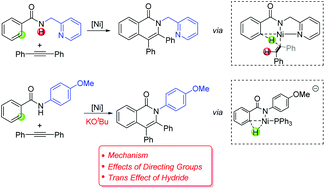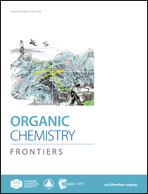A computational mechanistic study of Ni(0)-catalyzed annulation of aromatic amides with alkynes: the effects of directing groups†
Abstract
Directing groups (DGs) are widely employed to enhance the selectivity and reactivity of C–H activation. In this work, to illustrate the effects of mono- and bi-dentate DGs, we systematically explored the Ni(0)-catalyzed annulation of an aromatic amide containing N,N-bidentate or monodentate amide nitrogen DG with alkyne through density functional theory (DFT) calculations. For an amide featuring bidentate 2-pyridinylmethylamine DG, the proposed mechanism involves oxidative addition of the N–H bond, alkyne insertion into Ni–H, C(sp2)–H activation via concerted metalation deprotonation (CMD), alkyne insertion into Ni–C(sp2) and reductive elimination. However, under the same reaction conditions, the oxidative addition of the N–H bond utilizing the monodentate amide NH DG is unfavorable, due to the lack of a distal N(sp2) coordination site. Deportation of amide NH by a strong base allows the amidate anion to coordinate with the metal center, and the catalytic cycle involves oxidative addition of the C(sp2)–H bond, sequential alkyne insertion into the Ni–H and Ni–C bonds and reductive elimination. The significant difference between the two reactions is the C–H activation process; that is, C–H cleavage occurs via the CMD mechanism in the bidentate DG while oxidative addition in the monodentate DG. The sequence of alkyne insertion and the structural trans effect of the hydride were also deeply investigated.



 Please wait while we load your content...
Please wait while we load your content...